Repair Topics
Testing Water Heater Thermostats
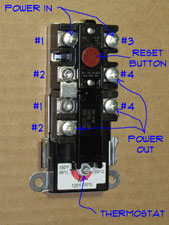 Testing water heater thermostats is important in locating water heater problems. The upper thermostat controls both the upper and lower element. When it goes bad you don't have any hot water at all.
Testing water heater thermostats is important in locating water heater problems. The upper thermostat controls both the upper and lower element. When it goes bad you don't have any hot water at all.
This article deals with 'Thermostats' on Electric Water Heaters. For thermostats on Gas Hot Water Heaters you will need to see the article 'Gas Water Heater Thermostats' for more information.
Not sure if this is your problem? See 'Troubleshooting Electric Hot Water Heaters' or 'Water Heater Element Testing' for other related topics.
The lower thermostat just controls the lower element. When the upper element works and the lower one does not you have a low supply of hot water.
The thermostats are less likely to be at fault than the elements. However they do go bad and testing water heater thermostats is still required. Your water heater usually has two elements and two thermostats.
The upper thermostat has two functions. First it allows the upper element to heat the water in the top of the tank. When this water is hot enough it shuts the upper element off. Then it allows power to go to the lower element.
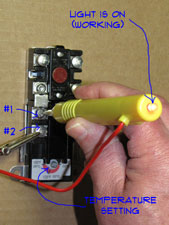 Make sure that the power is off. Turn the temperature to its highest setting on the upper element. This insures that the thermostat will call for heat. You want to use the water heater tester to check terminals #1 and #2 on the upper element (this will be the lower set of #1 and #2 terminals). You should get a glow or light if the contacts are engaging. No light, bummer, the thermostat is bad. See 'Replacing an Electric Water Heater Thermostat' for instructions on what to do.
Make sure that the power is off. Turn the temperature to its highest setting on the upper element. This insures that the thermostat will call for heat. You want to use the water heater tester to check terminals #1 and #2 on the upper element (this will be the lower set of #1 and #2 terminals). You should get a glow or light if the contacts are engaging. No light, bummer, the thermostat is bad. See 'Replacing an Electric Water Heater Thermostat' for instructions on what to do.
We are going to get into a weird area here. The next test depends on whether you have simultaneous or non-simultaneous element operation. What! Are you kidding? What does that mean? Most electric hot water heaters are non-simultaneous operation. Meaning that only one element heats at a time. Simultaneous means that both elements can heat at the same time.
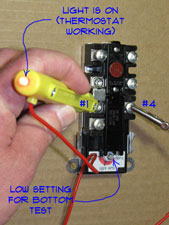 How do you tell the difference? First simultaneous operation requires a bigger breaker and heavier wire. You will likely have a 45 or 50 amp breaker for your hot water heater. Non-simultaneous will only have a 30 amp breaker. Second a non-simultaneous water heater will have a lower #4 terminal on the upper thermostat. Simultaneous operation will not have the second #4 terminal. Is the water heater element testing thing confusing or what?
How do you tell the difference? First simultaneous operation requires a bigger breaker and heavier wire. You will likely have a 45 or 50 amp breaker for your hot water heater. Non-simultaneous will only have a 30 amp breaker. Second a non-simultaneous water heater will have a lower #4 terminal on the upper thermostat. Simultaneous operation will not have the second #4 terminal. Is the water heater element testing thing confusing or what?
Assuming that you have non-simultaneous operation, continue with this paragraph. Next you need to check the contacts that control the lower element. You want to set the temperature on the upper thermostat to it's lowest setting. Turn it until it clicks off. This should insure that upper element is not calling for heat. This will only work if the water in the tank is warm. With ice cold water the test will fail.
We are talking about process of elimination here. Is the upper element good? Do you have power to the elements and thermostats? The water is not heating? Replace the upper thermostat, see the link in the previous paragraph.

Use the tester on terminals #1 and #4 (remember, the lower #1 and #4). Again the light should come on or glow. No light, time for a new thermostat.
To check the lower thermostat you need the upper thermostat turned off. The lower thermostat needs to be turned to its highest setting. This should insure that lower thermostat is allowed to engage. Use the water heater tester to check terminals #1 and #2 (the lower set).
The whole simultaneous dissertation does not matter for this one (boy, what a relief). You should get a glow or a light if contact is made. No light, then the bottom thermostat is bad.
Summary
Electric water heater thermostats are a fairly simple devices that can fail from time to time. Testing is the only option if you want to determine whether or not one or both of them has failed.
If the thermostats are okay, you need to test the water heater elements. See 'Testing Electric Water Heater Elements' for more information.
Testing for Ground on Water Heater Elements
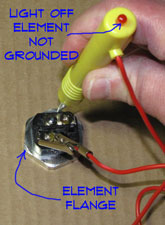 Testing for ground on water heater elements is a fairly simple test that only takes a few minutes. You should also 'test for continuity' at the same time. These tests require that you shut off the power to the water heater and remove the access panels.
Testing for ground on water heater elements is a fairly simple test that only takes a few minutes. You should also 'test for continuity' at the same time. These tests require that you shut off the power to the water heater and remove the access panels.
Not sure if this is the right place? See 'Troubleshooting for Electric Water Heaters' or 'Gas Water Heater Troubleshooting' for all of the water heater problems and resources.
What Does 'Testing for Ground' Mean?
Testing for ground on a water heater element is similar to 'testing for continuity'. However, the failure is completely different. The metal part of the heating element is kept separate from the metal in the tank by a plastic insulator. If this cracks or loosens, the water in the tank will cause it to short out.
If the current goes into the tank and back through the ground wire, the element fails to heat up and you don't have any hot water. So the term 'testing for ground' means to test and see if the element is grounding out into the metal on the tank.
Using the Right Tester
To check for ground you need to use a continuity tester. This is a battery operated tester that runs a small current through a device or wire to see if it is carrying electricity.
NOTE: This test can also be done with a multi meter. Multi meters are a little tricky to use and beyond the scope of this article. Check out Using a Multi meter, for more information.
You can purchase a simple water heater tester for around $10. This performs the same tests that you would use a multi meter for and it is a lot simpler to use. Do you already have a multi meter? Do you know how to use it? Great, you're all set.
Checking for Ground
Shutting Down the Power
The first thing you to do is make sure the power to the water heater is off. Go to the main panel and turn off the breaker for the Hot Water Heater, it should be marked on the legend.
It is very important to make sure the power is off. See the article on 'Shutting Down an Electric Water Heater' for more information. If you elements do turn out to be bad, you are going to have to follow all of the shut down steps.
Accessing the Water Heater Elements
An electric water heater has two elements, an upper and a lower. There are cover plates on the outside of the tank that are held in place by a couple of screws. Remove the cover plates to get to the element ends and the thermostats.
Typically the elements are below the thermostats. The upper thermostat will have a red reset button on it.There may be some insulation that needs to be pushed back out of the way. See the picture to help you identify the element.
Testing the Element for Ground
Checking ground on water heater elements if similar to testing the element. Make sure the power if off before beginning. Double check with a voltage tester.
Similar to Step One, the power needs to be off and the wires removed. Clamp one of the terminals to one of the lugs on the element. Touch the other lead to the metal element flange. This time no light is good.
If the light glows it means that the element is grounding out and needs to be replaced.
The Element Passed - Next Steps
Passing this test does not necessarily mean that you are out of the woods. Obviously, you are here because you either don't have enough hot water or you have no hot water. So, if the element passed the continuity test, there is still something wrong.
You will also need to test and see if you element is maintaining continuity. See the article, 'Testing a Water Heater Element for Continuity'. This is another simple test that determines whether or not the electrical current is passing through the element correctly. If power fails to go through the element, it will not heat up.
What If the Test Fails?
If the 'ground' test fails, the element is shorting out and will need to be replaced. There are no other options, elements cannot be repaired and there are no replaceable parts
You need to test both elements to see if they are both bad. Perform the 'ground' test on the other element to make sure it is not shorting out.
Replacing the Elements
What If Only One Element Failed?
New elements will cost between $15 and $40, so there is a cost consideration when only one is bad.
With that said, there is some common sense to be applied here. If only one element has gone bad it is very likely that the other one is not far behind. There is a fair amount of work involved to change one element. It makes sense to replace both of them at the same time.
Purchasing and Installing Elements
Replacing the elements is a job that requires draining the tank. You will want to see the article 'Installing Electric Water Heater Elements' for complete instructions on performing.
Water Heater Element Testing
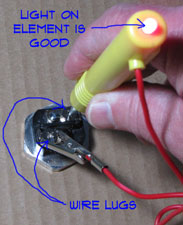 When you don't have hot water your elements may be at fault. Electric water heater element testing is one way to determine if one or both of them are bad.
When you don't have hot water your elements may be at fault. Electric water heater element testing is one way to determine if one or both of them are bad.
For a typical electric water heater you have four items that may have failed. Any one of them can cause you to have less hot water or no hot water. The first thing to check is the elements themselves. There are two simple tests that can tell you if they are bad. See the articles, 'Testing Water Heater Elements for Continuity' and 'Testing Water Heater Elements for Ground'.
The other common item is the thermostats. There are two of them, see the article 'Testing Electric Water Heater Thermostats' for a discussion and instructions on checking them.
How Water Heater Elements Work
Most electric hot water heaters have two elements. One or both of them could go bad. In addition there is a thermostat for each one.
If the thermostats go bad the elements won't heat up. Is this something you can do? The answer is probably yes. A couple of testers and a few precautions and you are all set.
There are a couple of simple test that you can perform to find out where the problem is. An element tester or multi meter and a voltage tester are all that you need.
Water Heater Element Testing - Information
What Can You Save?
New elements are around $10 to $20 each. A serviceman will likely change them if he comes out. The bill will be $225 to $275. About two hundred of that will be for the installation. Finding out what you need first is a good idea.
How Hard Could It Be?
Water heater element testing is not that hard, you just need a few testers.
Check the Simple Things!
Check the circuit breaker first. Make sure the it has not tripped. Each thermostat has a reset button (Well, not always, the lower one may not have one). You have to remove the covers and shut the power off to reset them.
What Can Go Wrong?
Only perform water heater element testing when the power is off. Electric hot water heaters have powerful current in them. You can be seriously hurt or even killed from a shock. Make sure the power is off. In addition, the current can ruin the testers.
Checking for Power
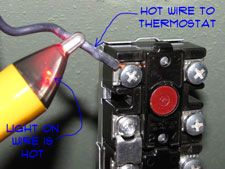 Checking for water heater power is a must on an electric hot water heater. Unlike a gas hot water heater, an electric unit will not work when the power is off.
Checking for water heater power is a must on an electric hot water heater. Unlike a gas hot water heater, an electric unit will not work when the power is off.
The first obvious thing you want to check is the breaker. The electric water heater should be on a dedicated two pole circuit in your breaker box. See if it has tripped. No power, no hot water. If the breaker has not tripped you will want to see if you have power at the hot water heater. Shut the breaker off for the hot water heater.
Remove the covers for the upper element and thermostat. Remove the insulation and protective cover. The two hot wires should be at the top of the thermostat. Turn the power back on and carefully use a non contact tester to check for power. Make sure the tester is working on something that you know is working. Do you have power? Then it is time to check the elements.
WARNING!! Make Sure the Power is OFF!!! BEFORE You Work on Electrical Devices!!!
Troubleshooting Water Heater Element Issues
The only way to tell if a heating element is bad is to test it. The article, 'Testing Water Heater Elements' covers this subject and you can review it by following this link.
A grounded element will not work, even if the element itself is good. To find out if the element is grounded in the article 'Checking for Grounded Heating Elements'.
The thermostats control the elements and the upper thermostat also controls the lower one. This article on 'Testing Water Heater Thermostats' gave you the information you need.
How To Turn On a Water Heater
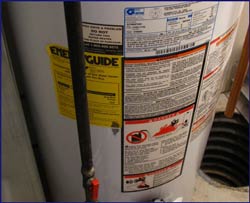 The method for how to turn on a water heater involves a few steps. It sounds like a simple thing, but there is procedure that should be followed.
The method for how to turn on a water heater involves a few steps. It sounds like a simple thing, but there is procedure that should be followed.
You will have to follow different steps for gas and electric water heaters. Propane water heaters will be the same as natual gas. If you are not sure what type of water heater you have, see 'Water Heater Types'.
Not sure if this is the right solution for your problem? See 'Troubleshooting Gas Water Heater Problems' for information on gas hot water heaters.
For an electric water heater see 'Electric Hot Water Heater Troubleshooting' for information on identifying your exact problem.
For general water heater isssues with hot water heaters see 'Hot Water Heaters General Topics' for more information.
Turning On a Gas Hot Water Heater
The steps for starting up a gas hot water heater are listed below, with explanations to follow:
(1) Close any open faucets or vavles.
(2) Turn on the cold water supply.
(3) If the gas was completely off, re-lite the pilot light.
(4) If the gas valve was turned to 'Pilot', turn it to 'On'
Step One - Close Open Faucets
If you were working on your hot water tank, you should have opened a faucet to allow air to get into the tank. This prevents the creation of an airlock. Now that you are ready to turn the water back on, you can close the faucets.
Step Two - Turn On the Cold Water Supply
Before you turn the gas back on and light the pilot, you want to turn on the cold water and let the tank refill. The heating elements should not be turned back on with a partially filled tank.
At this point the tank will fill with water, replacing any that was lost while working on the tank.
 Step Three - Light the Pilot Light
Step Three - Light the Pilot Light
Every water heater has a slightly different procedure for lighting the pilot light. See the article on 'how to light a gas water heater pilot light' for complete instructions.
Step Four - Turn the Gas Valve to On
If you were able to just turn your gas valve to 'Pilot', you will not need to light the pilot light. Instead, you should be able to turn the gas valve to 'ON'.
The water heater should start heating the water at this point. So the burner should fire up. If for some reason it does not, you will need to follow the complete pilot lighting instructions. See the article on 'lighting pilot lights' for information.
Turning On an Electric Hot Water Heater
The steps for starting up a gas hot water heater are listed below, with explanations to follow:
(1) Close any open faucets or vavles.
(2) Turn on the cold water supply.
(3) Remove the lock out tag from the breaker box.
(4) Turn on the circuit breaker for the hot water heater.
Step One - Close Open Faucets
If you were working on your hot water tank, you should have opened a faucet to allow air to get into the tank. This prevents the creation of an airlock. Now that you are ready to turn the water back on, you can close the faucets.
Step Two - Turn On the Cold Water Supply
Before you turn the power back on, you want to turn on the cold water and let the tank refill. The heating elements should not be turned back on with a partially filled tank, it can damage them.
At this point the tank will fill with water, replacing any that was lost while working on the tank.
 Step Three - Remove the Lock Out Safety Tag
Step Three - Remove the Lock Out Safety Tag
This is the piece of tape that you should have put over the breaker warning anyone that gets into the panel not to turn that breaker on. This a safety procedure that can prevent shocks and even death.
Step Four - Turn On the Water Heater Breaker
There is no indicator light on most electric water heaters to tell you that the unit is on. You should hear some sounds that indicate the the heating elements have engaged and the water is starting to heat.
The water heater should start heating the water at this point. Witin 30 - 60 minutes you should have hot water. Carefully check one of the faucets to make sure the water is getting hot.
How To Turn Off a Hot Water Heater
 This article primarily deals with how to turn off a gas hot water heater. Failure to follow the proper steps may result in damage to the internal elements of the water tank. There are only a handful of steps and they are easy to follow.
This article primarily deals with how to turn off a gas hot water heater. Failure to follow the proper steps may result in damage to the internal elements of the water tank. There are only a handful of steps and they are easy to follow.
In most homes you have one of two types of water heaters, gas and electric. For the purposes of this discussion, propane would also be considered gas. If you have an electric hot water heater, see the article 'How To Shut Down an Electric Hot Water Heater' for instructions on this type of unit.
Got other issues that you need to address? See 'troubleshooting gas water heaters' for all types of gas water heater problems 'troubleshooting electric water heaters' for information on all types of electric water heater problems.
Identifying Water Heater Types
Not sure which kind you have? There are a couple of telltale signs that make it easy to identify which style you have. For an electric water heater, the wiring coming into the top of the water heater gives it away. Also, electric water heaters do not have vents, since they do not burn anything to heat up.
A gas water heater is identified by the vent at the top. This can be metal or plastic, depending on the efficiency level of your hot water heater. A gas water heater also has a gas line that attaches to the unit near the bottom.
How To Identify a Gas Hot Water Heater
Burner Assembly
A telltale sign of a gas water heater is the gas valve and burner assembly at the bottom of the water heater. The gas valve will have a heavy metal gas pip attached to it. It will have a burner assembly below it that will be covered by a removable plate. This plate will protrude around the lower gas line and thermocouple connector.
It is usually possible to see a pilot light through a window after the outer cover plate is removed. Gas water heaters use a burner that has an open flame to heat the water.
Fume Vent at Top
Gas hot water heaters burn natural (or propane) gas to heat the water. Burning fossil fuel produces harmful gases. Therefore, a gas hot water heater will always have a vent of some kind.
The type of vent depends on the efficiency of the hot water heater. Higher efficiency units will use a plastic pipe the vent through an outside wall. Lower efficiency unit will vent into a masonry or metal chimney. Electric water heaters will not have any type of venting apparatus.
Gas Lines
Of course it stands to reason that that a gas hot water heater would use natural or propane gas to operate. This type of gas is a low pressure fuel that requires a fairly large piping system for delivery.
The burner assembly mentioned above will need piping connected to it. This piping will be obvious when you look at the water heater. It will be attached to the gas valve at the bottom of the unit and usually be connected on the left side when you are facing the water heater.
Lack of a Vent
Electric hot water heaters do not have vents. Vents are required on gas water heaters to remove toxic fumes. Electric water heaters do not generate fumes and therefore do not have a vent.
Vents can be made of metal or plastic and usually go into a chimney, metal vent pipe or through an outside wall. An electric water heater will only have the water inlets and a power cable at the top of the unit. NO VENT will be present.
Upper and Lower Access Panels
Electric hot water heaters use heating elements to heat the water. Most of them have two elements, an upper and a lower element. The elements are behind access panels on the side of the water heater. The spacing of these panels will vary, but usually one is near the bottom and the other can be anywhere from the middle of the water heater to near the top.
The panels may be a different color or the same color as the rest of the water heater housing. They are generally held in place by two screws and are easily removed.
A gas water will have a gas valve and burner access panel at the bottom of the water tank only. There will not be any access panels higher up on the housing.
No Gas Burner
An electric hot water heater uses internal heating elements and does not require a burner assembly. On a gas water heater the burner assembly is prominent at the bottom of the hot water heater
Not sure which kind you have? There are a couple of telltale signs that make it easy to identify which style you have. For an electric water heater, the wiring coming into the top of the water heater gives it away. Also, electric water heaters do not have vents, since they do not burn anything to heat up.
A gas water heater is identified by the vent at the top. This can be metal or plastic, depending on the efficiency level of your hot water heater. A gas water heater also has a gas line that attaches to the unit near the bottom.
No Gas Lines
An electric water heater will not have a gas line attached to the water heater. Gas lines are fairly heavy pipes that have large fittings on them. It is called black pipe, since it is black and oily when it is manufactured. The gas line connects at the bottom of the water tank at the gas valve. You will not see any of this on an electric water heater.
Shutting Down and Gas Hot Water Heater
There are four steps to properly shutting down a gas hot water heater:
(1) For working on water pipes or draining the tank, turn the gas valve control to pilot.
(2) For any other work on the hot water heater, turn the gas completely off.
(3) Cool down the water inside of the tank.
(4) Shut off the cold water supply to the hot water tank.
(5) Open a hot water faucet somewhere, (preferably above) in the house.
Step One - Setting a Gas Valve On 'Pilot'
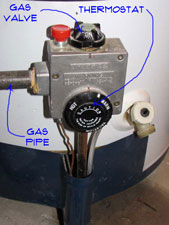 The water heater gas valve is located toward the bottom of your water heater just above the burner chamber. On the top of the gas valve that has various settings on it. The three main settings are 'OFF', 'Pilot' and 'ON'.
The water heater gas valve is located toward the bottom of your water heater just above the burner chamber. On the top of the gas valve that has various settings on it. The three main settings are 'OFF', 'Pilot' and 'ON'.
Turning the dial to 'Pilot' will shut the gas off to the burner without shutting off the pilot light. This setting can save you the trouble of having to light the pilot again when you are done. This setting should not be used if you are doing any work on the burner assembly or the gas line. It is suitable to use when you are draining the tank or working on the water lines.
Step Two - Turning the Gas OFF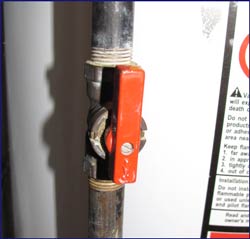
The safest thing to do whenever you work on your gas hot water heater. Leaking gas can explode and is quite dangerous.
First turn the dial on the gas valve to 'OFF'. Turning the gas valve to 'OFF' does not completely shut off the gas. There is a ball valve on the gas piping next to the water heater. This valve should be turned 90 degrees until the handle is perpendicular to the pipe.
With the gas valve shut off, the gas is completely turned off and the water heater is safe to work on.
Step Three - Cool Down the Water
This is an important step. Water that is directly out of the gas hot water tank can be very hot and scald or burn you. Run and considerable amount of hot water through one of the fixtures until the water is just warm. Do not mix it with cold water, run it pure hot. The cold water running into the tank will dilute the hot water and reduce the temperature.
After the water has cooled down, it is safest to work on the water heater.
Step Four - Shut Off the Cold Water Supply
Do not shut the water off if you have not turned the gas going into your gas hot water heater off. If the water continues to heat inside the water heater after the water is shut off the heater will build up too much pressure. If you are sure the water is off, you can turn off the cold water supply.
Step Five - Open a Hot Water Faucet
Opening a faucet will prevent the water heater from developing an air lock. Any attempts to drain the water tank will fail if a faucet is not open to provide air.
It should now be safe to work on your hot water tank.
Step Five - Draining a Hot Water Tank
Most repairs on a gas hot water tank can be made without draining the tank. There are, however a few exceptions that must be noted.
Removing or replacing a gas valve will require the tank to be drained. This part threads directly into the lower portion of the tank. Another activity that requires an empty tank is flushing out the sediment. Clearing out water heater sediment on a annual or semi-annual program is a good maintenance program. Draining the tank is a chore, but the steps required are also required for the sediment flush, so it is really not any extra work.
Where To Next?
After you have completed your repairs you are going to need to get your water heater working again. See the article, 'Starting Up a Hot Water Heater' for instructions. The steps are similar to shutting a water heater down, you just want to get them in the right order.


